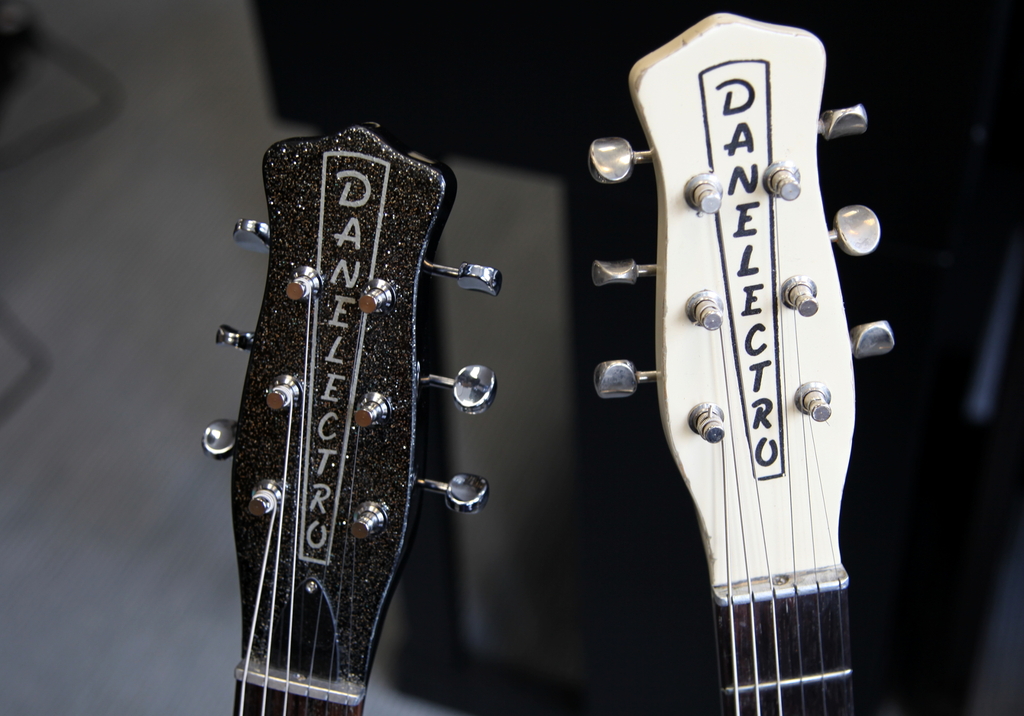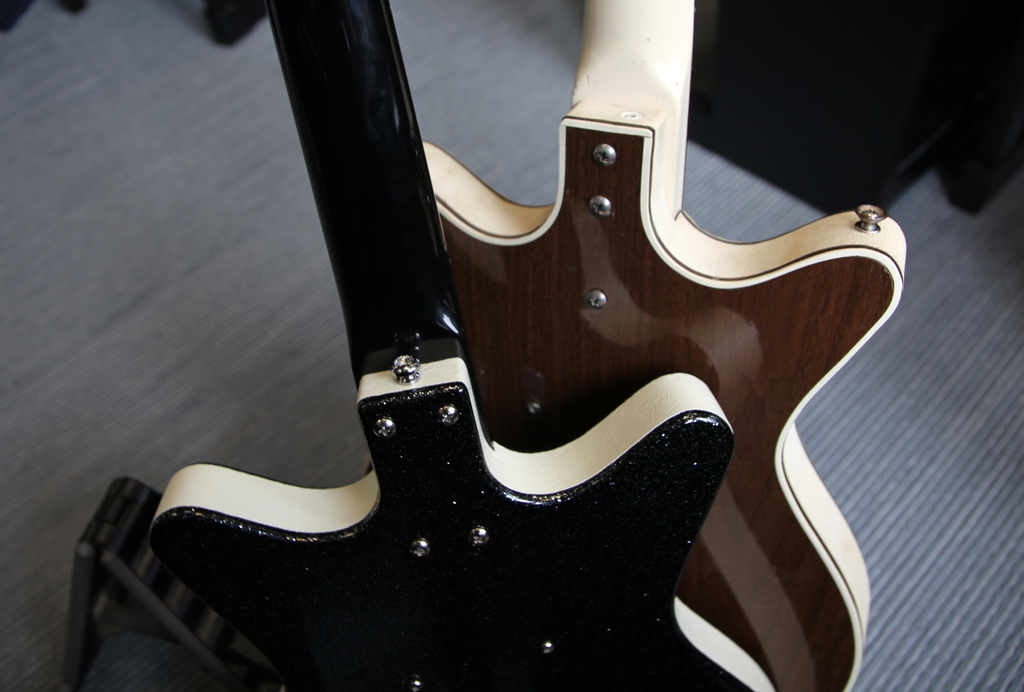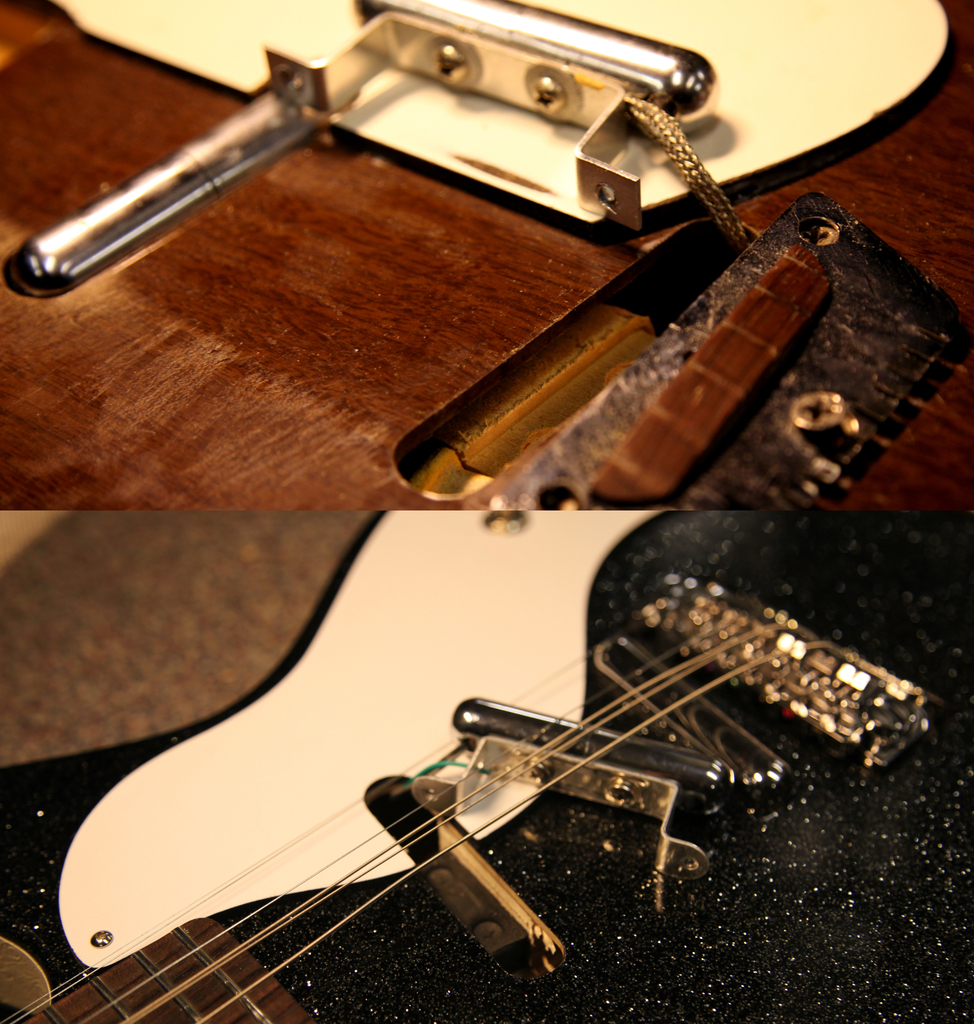Danelectro Reissues: how do they compare to the originals?
Regular readers of our blog will no doubt be aware that we’re big fans of the modern Danelectro brand: what we haven’t touched on is that we also love the originals, and we thought it might be interesting to do a comparison. The most popular model in the current range is the DC59 based on Jimmy Page’s legendary 3021 model Danelectro, and I’ve been doing some restoration work this month on an original ’59 Danelectro – it seems like a good opportunity to get them up on the bench and see how they compare.
View Danelectro reissues for sale at Forsyths
A bit of background
Danelectro was founded in 1955 by Nat Daniels in Neptune, New Jersey, and they were always something of an oddity in the guitar world. There was no shortage of companies producing high quality guitars in the US in the mid 50s: indeed, this was the start of the golden era of the solid body electric guitar. Likewise, many companies saw the commercial potential of producing cheap solid body guitars that could be marketed to amateurs who aspired to playing Gibsons and Fenders but were restricted to more modest budgets – but these instruments were typically designed with profit rather than playability in mind, and were not the most pleasant instruments to play.
Daniels had something rather noble in mind: understanding that sky high actions and clubby baseball bat necks were hardly the best way to encourage a beginner to persevere with their instrument, he set out to design an instrument that would be cheap to manufacture yet would offer the same playability and comfort expected of much more expensive instruments.
The first Danelectros were odd affairs, the necks being built around a thick aluminium tube and having a peculiar box like profile. By1956 however this had been refined into a rather better design with aluminium rods providing the reinforcement to a comfortable, Fender like neck profile and the first of the classic Dano designs, the U2 was born. The double cutaway model nicknamed the Short Horn and favoured by Jimmy Page followed in 1959 along with a series of other designs that are now represented in the current range of reissues. With impeccable timing, Daniels sold the company in the late 60s just before the onslaught of Japanese budget guitars began to demolish the popularity of US made budget instruments, and the company closed its doors in 1969.
In the 1990s the Danelectro brand resurfaced with a range of reissue U style guitars made in Korea, rapidly expanding to cover the majority of the most popular original designs. The original Korean line possibly expanded a little too quickly and the line briefly disappeared again to be replaced by cheaper Chinese made products – this move has recently been reversed and the guitars are again being sourced from Korea. This most recent version of the company has been bowling us over with some really great, affordable instruments.
Our subjects
Representing the current line is a DC-59 in a rather vivid Black Sparkle. This model is based on the 3021 with twin lipstick pickups and the stylish ‘seal’ shaped pick guard, with a Jimmy Page inspired Badass style bridge replacing the more typical Dano metal bridge. In the vintage corner is a 6027 Deluxe that has been through the wars but which has recently been brought back to its original glory. The 60 series Danelectros were similar to the original Short Horns with surface mounted controls rather than the large guard, and they featured binding and a wonderfully cheesy kitchen cabinet style wood finish – we have another old Danelectro with a more conventional finish on hand for when we talk about lacquer.
Here they are side by side:

Body
Although original Danelectros were usually painted inside and out, due to the ‘prefinished’ nature of the Deluxe the internal wood is left unfinished, so we can easily see the construction. Danelectros are typically hollow bodied designs comprising a wooden frame a bit like a tennis racket sandwiched between Masonite sheets for the top and back. The frame on the original is made mainly from pieces of Pine glued and stapled together, with a block of Poplar being substituted in the neck pocket area to offer better support for the neck screws. The wood is pieced together pretty haphazardly and band-sawed into shape with little concern for aesthetics. There is a tongue that extends from the neck pocket to the bridge, contacting the back but not the top, and a Pine block underneath the bridge that contacts both.
The reissue is a little neater internally and the frame is made from plywood. The edges are still rough but they have been routed into shape and follow the outline somewhat more faithfully. The tongue and bridge block are also plywood and it looks as though it is all one piece. The tongue on the reissue contacts both the top and the back. It feels significantly heavier than the original and the plywood is probably the cause of this.
The top and back of the original are made of Masonite. This is a US trade name for a product similar to hardboard in the UK and is made from steam cooked, pressure moulded wood fibres. It’s a little less unpleasant to work with than MDF type materials in that there are no resin products used in the manufacture. The original has a slightly rough feel to the inside. The spec sheet for the reissue also specifies Masonite but it’s a smooth material and, looking at the pick guard which is made from the same material and unpainted on the inside, looks a little more like MDF. The back and top are a little thicker than the original as well.
Both guitars have the iconic Danelectro vinyl tape around the edge of the guitar: this disguises the wood joins whilst adding a major aesthetic component of the design.
In terms of finish, the original is a little unusual in using a Melamine type finish with a Walnut wood effect. The original 30 series Short Horns were finished in black or copper nitrocellulose and we have a 1961 Danelectro made Silvertone 1419 on hand to get a look at the finish. Compared to the nitro finishes used by Gibson and Fender in the same era the finish is a little rough looking – it’s hard to believe this was ever buffed to a high gloss to the level that a Gibson finish would have been. Still, the ’61 has aged extremely well and looks very good for its age. The reissue is finished in a thick coat of polyurethane and buffed to a high gloss. It doesn’t look as attractive as the thin coat on the ’61 but it is nicely applied and should be a good durable finish.
Bridge
The original Danelectro bridge was a simple affair comprising a metal plate mounted onto three screws with a Rosewood saddle that was adjustable for overall intonation. These saddles tend to wear over the years and ours has recently been re-profiled remove grooves caused by years of strings dragging across it. However, the biggest problem with the Rosewood saddle is that it offers no individual control over intonation so originals don’t intonate properly, and many owners swapped the bridges for alternative devices.
Amongst those who swapped out their Rosewood bridges was Mr Page who had his guitar modified with a Badass bridge unit, and the reissue goes for a replica of the Badass as its bridge of choice. It’s a decent piece of hardware and certainly allows for correct intonation, but unfortunately it’s countersunk into the top which makes string changes a bit fiddly – this isn’t a guitar you’d want to change a string mid set. The other Danelectros in the range use a bridge modelled on the original but with Fender style saddles to allow them to be intonated properly.
Neck
Another big structural difference between the original and reissue Short Horns is that the original has a non adjustable reinforcement to keep it straight and the reissue has a conventional modern two way truss rod. The reinforcement on the original is easy to see at the heel and comprises two aluminium rods that run from under the nut to the heel. Although you don’t have the option of setting the relief on this type of system, the neck of this nearly 60 year old guitar is straight as a die – it’s as rare to find original Danelectros with neck problems as it is to find pretty much any other 50s budget brand guitar without them! The adjustable rod in the reissue works well and it’s an obvious practical advantage to be able to adjust the guitar to suit the string type and player: no minus points for not copying the original. There is a small, neat looking truss rod cover at the headstock end.
The neck profiles on both guitars are a slim, modern feeling C shape – there’s perhaps a little more shoulder to the original but the reissue is a surprisingly close copy. Both have a metal nut slotted onto the end of the fingerboard. And both have slightly cheap looking plastic dot inlays for the position markers. The tuners on the original are single line Klusons, as the guitar most likely left the factory with although these ones are modern relics. The reissue has unbranded copies of the same tuners and they work well.
The actual neck join is considerably different on the original to the reissue. On the original the heel is narrow so that the bottom of the neck is visible on either side. There are three inline screws holding it to the body. The reissue has a conventional Fender type pocket with four screws. My guess would be that the original was limited to an inline setup due to the two reinforcement rods that run into the area a neck screw want to go into. Although this set up would likely be frowned upon today the join feels perfectly nice and tight on the original with just the three screws.
Electronics
The pickups in original Danelectros were famously built using tubes bought from a lipstick manufacturer and both guitars have the instantly recognisable lipstick tube pickups. The original pickups were slightly unusual affairs inside and out with the windings wrapped directly around an Alnico 6 magnet as opposed to around a bobbin and pole pieces. We can’t find accurate specs for the reissues although we believe they’re made using a bobbin to make winding easier. If anyone knows, give us a shout! The pickups on both guitars are adjustable via screws through the back of the guitar with a block of foam rubber pushing the pickup upwards against the pull of the screws.
Another distinctive feature of Danelectros was the dual concentric pots that allow volume and tone to be adjusted from the same pot, and the reissue also replicates this. Unfortunately our ’59 no longer has its original wiring loom and we’ve yet to source a set of original pots for it, so we’ll have to pass on examining the old one. Original Danos were very heavily screened to prevent electrical interference, and our original should heve had the electronics housed in an aluminium box – sadly that’s gone too. The pots in the reissue are a little limited, the tone control in particular essentially going from fully on to fully off very quickly with out much variation inbetween. Still, it’s all part of the character.
Sound
So, how does all this affect the sound of the guitars?
Unplugged the two guitars sound quite different to each other. The Reissue has a fairly familiar unplugged solid body tone with plenty of sustain and lots of zing on the wound strings. The ’59 is much darker and more acoustic like, still quite quiet but fuller and softer in attack. It’s a more pleasant guitar to play unplugged.
Plugged into a Fender valve amp set clean, the neck pickup on the ’59 has a very sweet, warm tone. The attack of the note is unusual and almost acoustic like, possibly as a result of the wooden saddle and a reflection of the unplugged sound. The neck pickup of the Reissue sounds more compressed and the sustain is better. It’s a little pokier than the ’59 and has a harder edge without as much warmth as the ’59.
Switching to the bridge pickup, the ’59 is very harsh and nasal, a real ice pick of a tone. It has its uses but I wouldn’t say it’s a versatile sound – possibly the very close location of the pickup to the bridge contributes to this. The Reissue’s bridge pickup pickup is significantly fuller in sound and has a pleasing Rickenbackerish quality to it.
In the middle position, the ’59 sounds lovely with a hollow, percussive edge that reminds us of a good vintage Strat in the neck / middle position. The warmth of the neck pickup really comes through and it’s a huge strength of the ’59, a great voice that really brings the guitar to life. The Reissue sounds quite big in the middle position with less hollowness – we tried comparing it to a Strat with Texas Specials and there was some similarity with the Strat on neck / middle. It’s a very usable sound but doesn’t have the magic of the ’59.
Cranking up the gain, the ’59 on the neck pickup has a very garage rock feel to it, very loose and indistinct. It’s quite sensitive to changes to the amp settings and with some careful tweaking we were able to get some nice indie guitar rhythm sounds out of it. Switch to the bridge pickup and it has real bite to it, again not a particularly versatile sound but it would really cut through a busy mix. It’s very raw and abrasive which is not necessarily a criticism, although if you’re looking for Claptonesque woman tone you might be best moving on. With both pickups the ’59 keeps much of the character of the neck pickup but the slightly percussive act the sound has a little more definition.
The reissue sounds much tighter than the ‘59 through the same gain settings and the extra sustain helps to give the guitar a more modern sound. The bridge pickup in particular has a lot more body than the ’59, and the middle position sounds huge on the Reissue.
In conclusion, we didn’t feel it was a straight win for either guitar. The ’59 has bags of character where the Reissue feels a little more generic, however the Reissue felt more versatile and would certainly lend itself to a wider range of applications, and for classic overdrive territory it came close to the sort of tones you might associate with a Rickenbacker 330 or a Telecaster whilst not completely losing the character of the original. The Reissue feels like a lot of guitar for the money, where as a good condition original double cut Danelectro with two pickups is – although cheap for a vintage guitar – still going to set you back a similar amount to a modern Rickenbacker or US Tele. We had a lot of pleasure playing both!
Some more photos to help compare the two:
Close up of the headstocks. They're pretty similar but the reissue has a truss rod adjustable from the headstock end. Note also the aluminium nut on both guitars:

Tuners are single line Klusons on the original and copies on the reissue:

The vinyl tape binding makes these two instantly recognisable as Danelectros. The original has a simple crosshatch whilst the reissue has a rather natty ostrich skin pattern. And no, that strap pin shouldn't be there on the original!

Here's an obvious difference: the reissue has a typical Fender style heel with four bolts, whereas the slender original has three in a line:

And here are the neck pockets from the inside. If you look closely at the original you can see the Poplar centre strip and Pine wings, and also notice the gap between the centre block and the top. The reissue is plywood and contacts the top and bottom:

Pickup cavities. The two guitars are pretty similar in this respect:

Internally the original is very messy with lots of glue runs and only roughtly cut to shape. The reissue is much neater and clearly routed rather than cut on a band saw. Both guitars have a solid block to support the block which you can clearly see in the photo of the reissue:

Putting the 6027 through its paces. Lots of fun to be had demoing these two guitars!

